MENUMENU
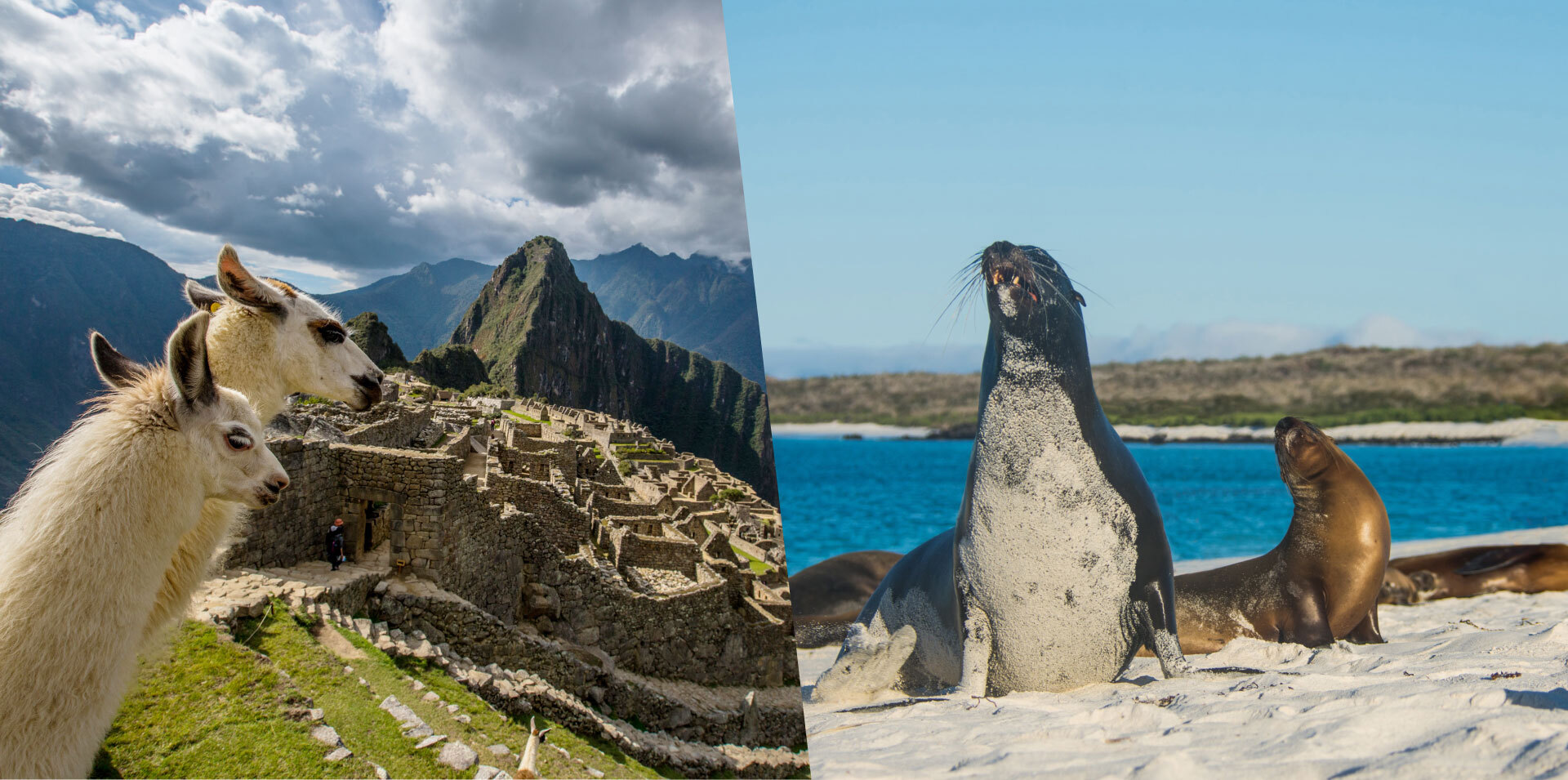
Reading time: 14 mins
In this blog, we’ll guide you through what it’s like to travel via the best tour package for visiting Machu Picchu and the Galapagos Islands, in addition to seeing a little of Quito, one of Latin America’s most beautiful cities. The experience is told by Carolina Witt, one of Metrojourneys’ destination experts.
Travel is one of the most enriching activities a person can enjoy. Many people think it all starts with the minute you take that first step off the plane; nevertheless, the journey begins as soon as you start searching for exciting destinations, casually read a few blogs, and check out a few travel deals. The idea of exploring a new country has found a place in your head and it’s waiting to blossom. Then, questions arise.
How is this tour going to be?
What experiences will I be part of?
Will it be worth the money I spend?
As seasoned travelers, we’ve had these questions as well! So, to help you clear those doubts, one of our destination experts took the trip of a lifetime to the Galapagos Islands and Machu Picchu.
The following is her testimony of this astonishing adventure! If you’re interested in knowing more about our Galapagos and Machu Picchu tour package, keep reading! You won’t regret it!
Traveling from Quito to the Galapagos Islands and Machu Picchu is a thrilling experience made all the more special by the sheer beauty of these incredible destinations and the high quality of service we received along the way!
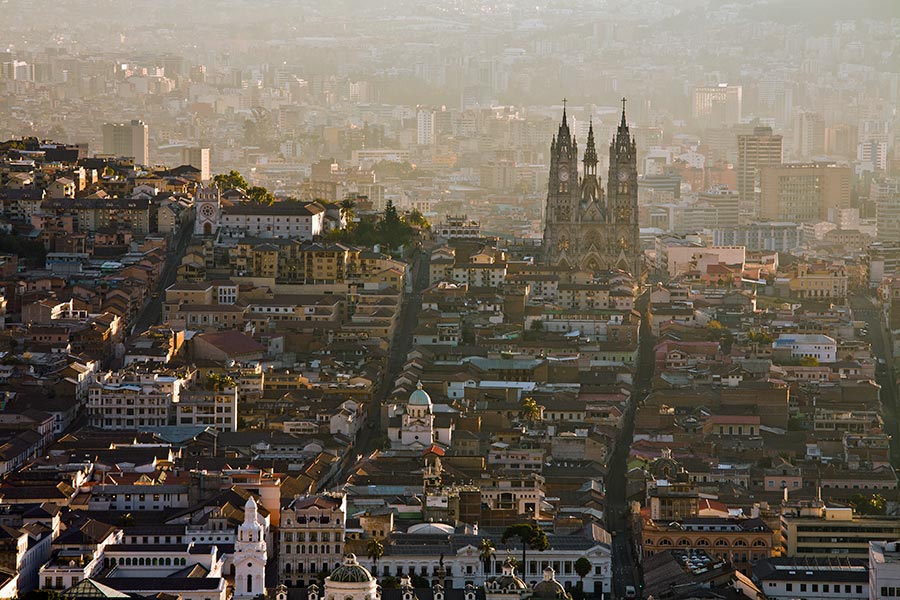
Panoramic view of Basilica of the National Vow in Quito, Ecuador
Our journey began with a shared shuttle service from one of Quito’s main hotels to the airport. Upon arriving at the terminal, Metropolitan Touring’s team provided us with assistance, not just with our luggage, but with all the paperwork and mandatory checkpoints we needed to navigate in order to fly to the Galapagos.
We learned a lot about the process. For instance, did you know that all luggage must pass through a special screening performed by INGALA, the National Institute for the Galapagos? This is a necessary measure to protect the fragile ecosystems of the archipelago. Among other items, travelers are prohibited from bringing any unprocessed food with them to the islands.
Following a short layover in Guayaquil, we arrived at the airport on Baltra Island in the Galapagos and were greeted by Metropolitan Touring team members. We boarded a shuttle that brought us over to the Itabaca channel. There, we boarded pangas (dinghies) that transported us to our ship.
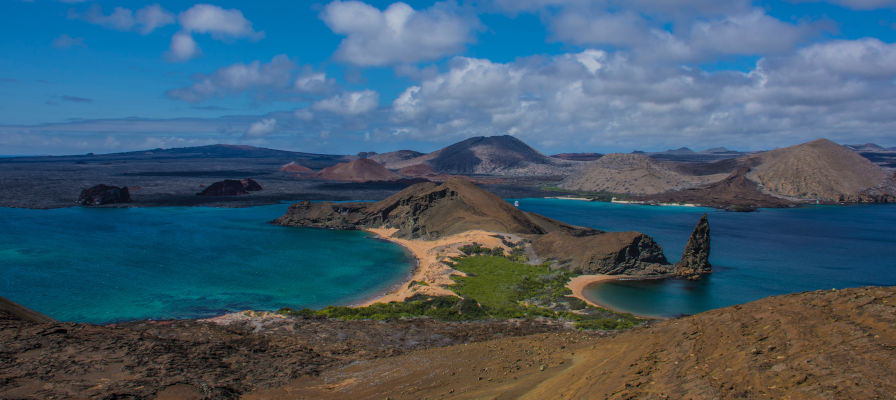
A view of Pinnacle Rock in Bartolome Island, Galapagos
Once aboard, we checked into our cabins. We were mightily impressed by the fact that our luggage was already waiting for us in our rooms! Before lunch, our captain gave us an official welcome and the crew led us in a zafarrancho, or safety evacuation drill. That same afternoon, we embarked on our first expedition through the islands.
Care to find out more about what you can find in the Galapagos,check out this amazing blog
Every day of our expedition was packed with excitement! Yet, somehow, we still had plenty of downtime to recharge and relax in between activities. For early risers, like myself, there were some really neat opportunities to observe the wildlife before breakfast.
Our naturalist guides kept us quite engaged with so much fascinating information about the islands and their curious inhabitants. The ship’s expedition leader also did a great job dividing the passengers into small groups based on what we were interested in seeing and doing. I think that helped each of us to get the most out of our experience in the Galapagos.
(Hey! Curious about what travel to a place as unique as the Galapagos is like? Learn about travel requirements for the archipelago here.)
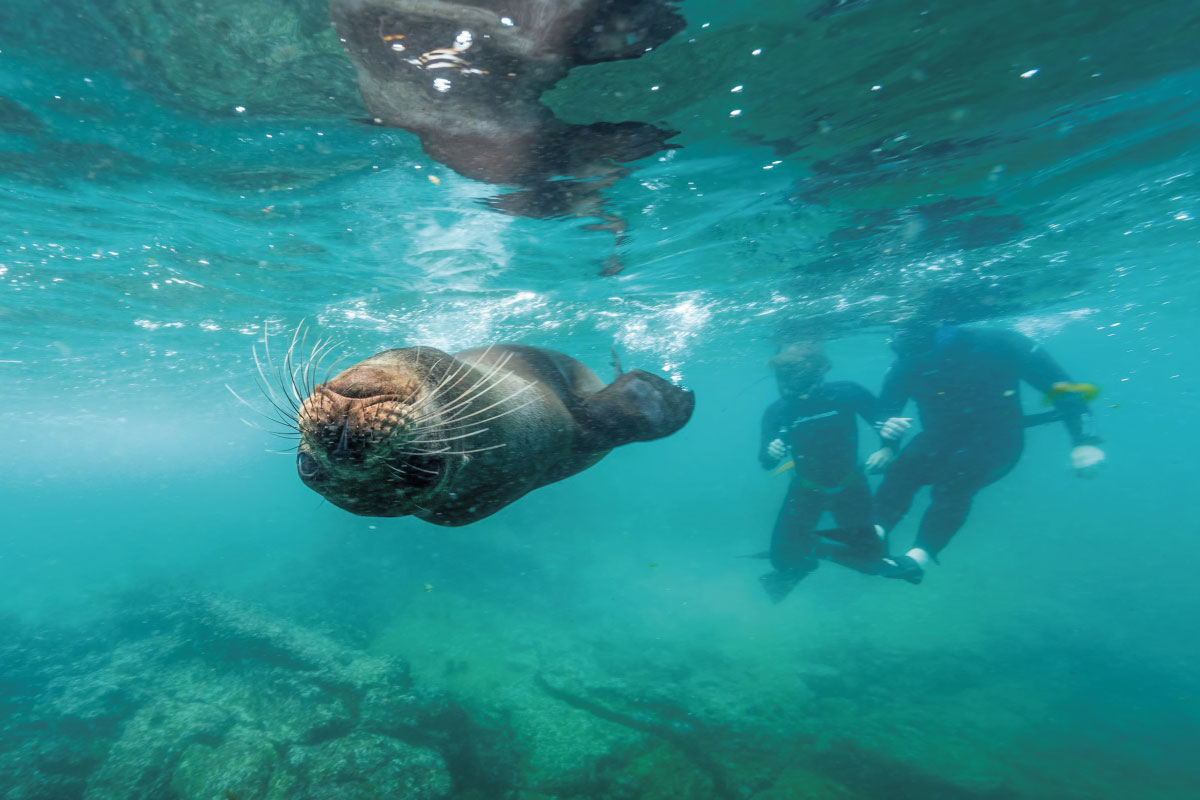
Sea lion swimming with tourists
The combination of activities, from coastal hiking to snorkeling and kayaking to paddleboarding, guarantees an exceptional and memorable experience of the Galapagos Islands, not to mention, the incredible cuisine served aboard the ship. I could’ve easily stayed another week just to keep exploring! However, after almost five full days, it was time to head back to the mainland and on to Peru!
On the morning of our last day, we disembarked from the ship and boarded our pangas back to the Itabaca Channel and then took a shuttle back over to the airport. As sad as we were to say goodbye to the Galapagos on such a beautiful morning, we looked forward to exploring the wonders that awaited us in Peru!
Following a brief layover in Guayaquil, we boarded our international flight to Lima, Peru. The number of travelers arriving in Peru can seem a bit overwhelming at first, but we were able to move through the Customs line pretty quickly. Upon exiting the baggage claim area, we immediately spotted our Metropolitan Touring team member, who was holding a sign with our name. They greeted us and took care of our luggage, guiding us towards the minivan in the nearby parking lot. They handed us each a bottle of water and a welcome kit with all of the materials and information we would need for this portion of our trip.
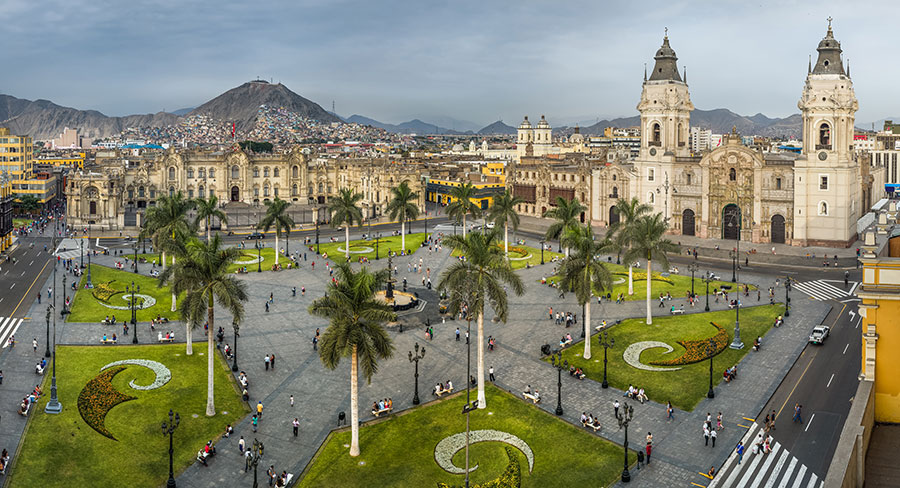
Lima’s main square, Peru
It’s important to note that Lima’s airport is actually in Callao, a nearby port town. With the traffic, it can take around an hour to reach the city.
Lima has three districts that are very popular with tourists. They are Miraflores, San Isidro, and Barranco. Many hotels and restaurants are situated in these districts. That said, a stroll along the shops that line the boardwalk at Larcomar will give you a pretty good idea of what modern Lima is like. This part of town rests along some cliffs overlooking the Pacific Ocean. And it’s easy to stare out at the beach and waves below.
On our full day in Lima, we took a driving tour that brought us around to Miraflores, where we got to see the famous Love Park by the beach, as well as the artsy and bohemian Barranco District. In the middle of the city, we got to see some fascinating Inca ruins, something we hadn’t expected to be able to see. Finally, we ended up in Lima’s historic center. The colonial architecture is so well preserved, it reminded us a bit of Quito’s old town, where we stayed just one week earlier. The famous Plaza de Armas is a great example of Spanish colonial-style structures and offers a nice contrast to the modern architecture we saw in Miraflores.
After visiting Lima’s various districts, I was ready to relax back at my hotel and prepare for our visit to one of the most iconic places in South America and the world, Machu Picchu!
The next morning, we enjoyed a wonderful breakfast, complete with avocado, granadilla (passion fruit), and several types of grains. We checked out of our hotel and headed off to the airport with our driver. This time, we took a different route along the coastline, which saved us almost 30 minutes and avoided the heavy traffic.
Upon arriving at the airport, a Metropolitan Touring team member assisted us with the check-in process and we proceeded to the boarding gate. Something that is worth noting: Lima’s airport is a very important transportation hub in Latin America. Meaning, it is always a very busy place. The airport is not very big, but the amount of people that pass through it is rather large. If you want to make your flight on time, arriving two or three hours prior to departure is really important.
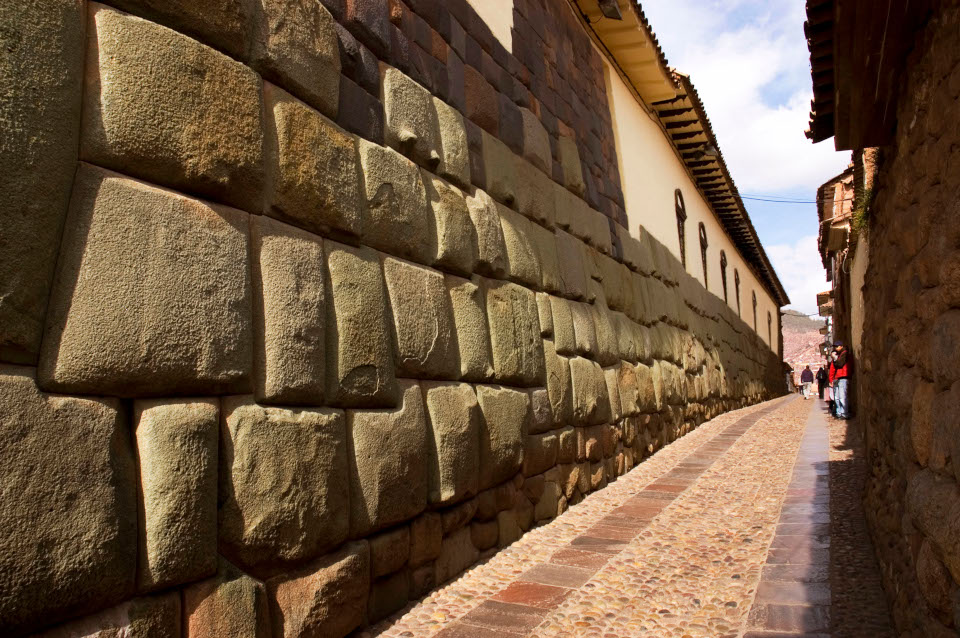
Cusco cobbled streets and paths
LATAM Airlines is one of the most important operators in the region, offering several daily flights between Lima and Cusco. We were quite impressed with the service aboard our plane. We were also quite impressed with the airport in Cusco, we noticed how much easier it was to move about this smaller airport.
After picking up our luggage we met our guide Ramiro. He was so knowledgeable and kind; what a gem. A good guide can truly make all the difference when it comes to travel!
Ramiro took us to the van. There, we met a very nice driver. We immediately started driving out of Cusco, descending to a lower elevation, and making our way to the Sacred Valley against the remarkable backdrop of the beautiful Andes Mountains. If you’re not accustomed to the altitude in Cusco, (what foreign visitor really is?), it can really hit you. Fortunately, our driver had a basket of candies ready for us. Sugar really helps to deal with altitude sickness. Coca leaf tea, which you can find in some of the markets, restaurants, and cafés in the region, can also mitigate the effects of traveling at such a high elevation.
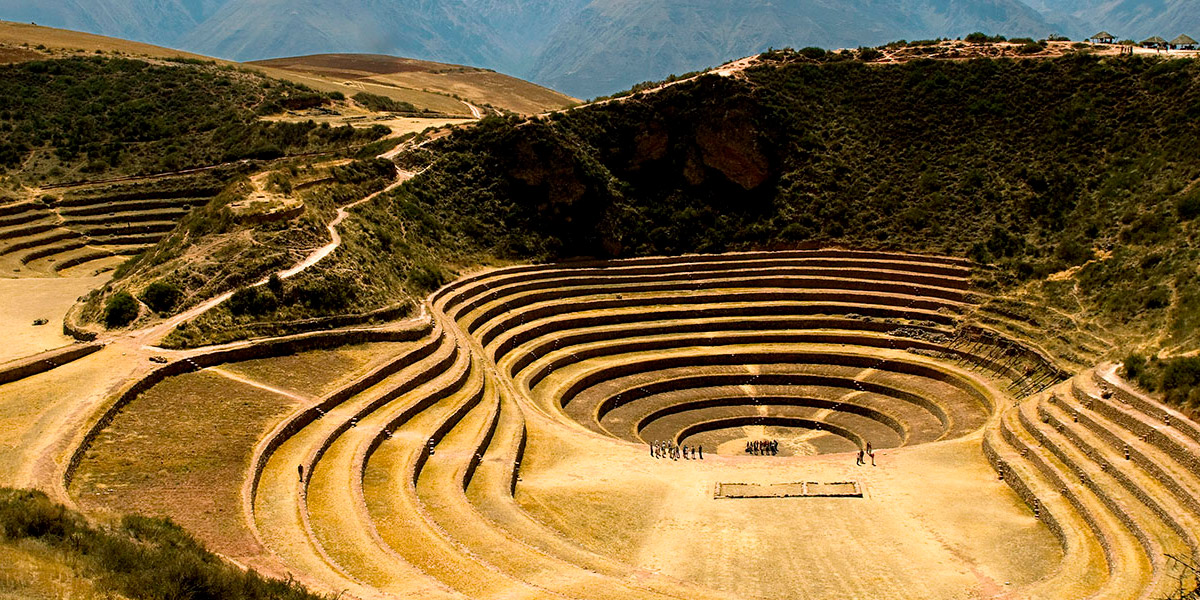
Sacred Valley in Cusco, Peru
On our way down to the Sacred Valley, we made a stop at Awanakancha. A very interesting spot, where we were able to see the different types of camelids famous in the region: llamas, llamingos, and vicuñas. We learned about their different wools and how these animals were utilized in ancient Inca cultures. They taught us how they create their fabrics using natural dyes, and how they treat the wool until the final product is completed.
The Sacred Valley is a magical place with a truly special vibe. You can see ruins all around you; on the side of a mountain and in nearby fields. Stunning views of the Urubamba River follow you along the way. Just sit back and enjoy the ride.
There are many things to see and do in the Sacred Valley, for instance, you can visit the Pisac Market, the Pisac Ruins, enjoy a really nice picnic on the banks of the Urubamba River. Visit the very famous Moray Terraces, Maras Salt Pans, or Chincheros in case you weren’t able to make a pit stop in Awanakancha.
Due to time restraints, we were only able to visit the Pisac Market and Pablo Seminario Clay Workshop. The market is large and colorful. Visitors can stroll around and get to learn about the culture through its handicrafts. Local women are dressed in vibrant skirts and hats that are quite eye-catching.
Sometimes, you’ll spot a baby llama, separated from their mother by one of the locals. These young llamas are often exploited and used as a prop for tourist photos. Ramiro pointed out that, if you see this, please be mindful; it is actually animal cruelty. One should never keep a baby llama apart from its mother for any length of time like this.
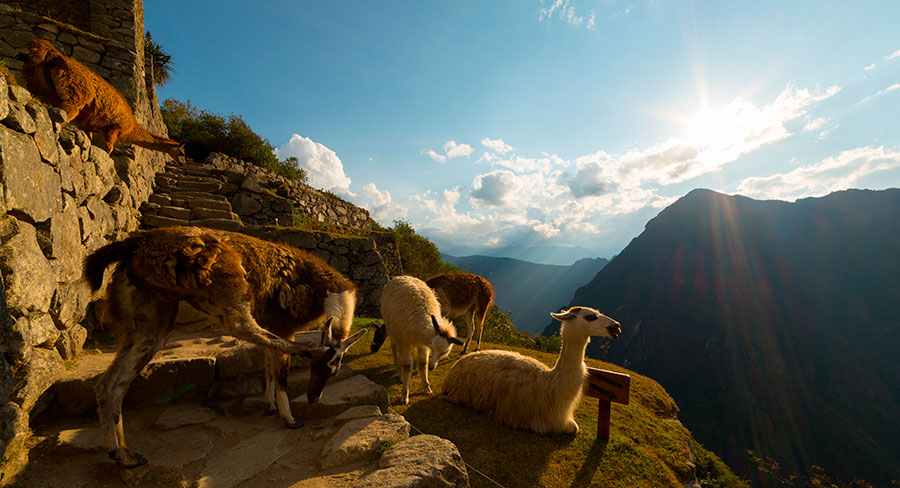
Group of llamas in Machu Picchu
We spent close to an hour at the Pisac Market before heading off to Pablo Seminario’s Clay Workshop. On the way, we had a delicious box lunch. Quinoa is readily available, so be ready to enjoy plenty of meals with this superfood.
Upon arriving at Pablo Seminario’s Workshop, we were introduced to this artist’s remarkable life, his achievements, and of course his handcrafts. If like me, you enjoy shopping for unique quality souvenirs from around the world, this is a golden opportunity!
Afterward, we were dropped off at our hotel in the Sacred Valley. Almost all properties in the region have an hacienda feel to them; large gardens, very nice rooms, and lots of interesting spaces. My hotel offered a stargazing activity at night. It was amazing! What a perfect way to end a magical day in the Sacred Valley!
The next morning, we had a very early breakfast before being picked up. We drove to the train station in Ollantaytambo. Unfortunately, I wasn’t able to visit Ollantaytambo, but if you have the time, please do so. Apparently, there is an amazing fortress and the region is gorgeous.
From there, we boarded the Vistadome Panoramic Train that transported us to the small village of Aguas Calientes, also known as Machu Picchu Town. It is important to keep in mind that this train is extremely punctual, and is always on time. Aboard the train, you can enjoy a marvelous view of the shifting landscapes, including the Urubamba River, the snow-capped Veronica Mountain, and of course, lots of Inca ruins all along the way.
Want us to go into detail about Machu Picchu and what travel there is like? Check out this amazing blog on what travel to Machu Picchu is like!
Upon arriving in Aguas Calientes (Machu Picchu Town), I recommend not dilly-dallying through this picturesque little town, rather, head quickly to the bus station and catch a shuttle that will take you to the entrance to the citadel.
These buses and vans carry around 16 passengers. You might have to queue for over 30 min, but once aboard the shuttle, the 20-minute ride will take you up the hill to the one and only Machu Picchu. Here, you’ll find bathrooms and, if you need to store large backpacks, lockers that you can rent for the day.
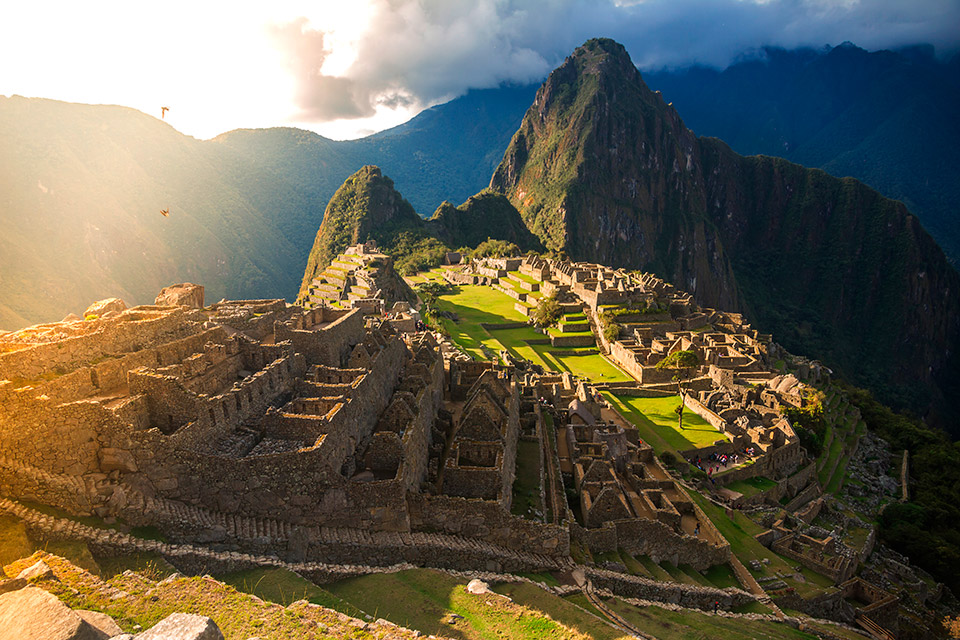
Sunset at Machu Picchu, Peru
Your experience inside the citadel is made all the more enlightening by the guide as they share about the site’s intricate history, explaining everything about its origin and how the site was laid out. They provide lots of interesting facts about the importance of the Urubamba River, the location of the citadel high up in the mountains, and more! It is impressive to note how well preserved the ruins are, despite the large number of tourists that cycle through each year.
One entrance fee affords you a four-hour visit. If you want to spend more time here, you would need to purchase a second ticket. Also, because this place is so popular, visits should be scheduled in advance. There is a lot to experience and explore in this one-of-a-kind place. It was everything I’d hoped it would be and more!
After exiting the citadel, we headed over to the Belmond, a hotel and restaurant in the immediate vicinity of the ruins. There, we enjoyed a delicious lunch. Afterward, we boarded a shuttle and headed back to Machu Picchu Town. This time, when we got to Aguas Calientes, I took a little time to roam around and explore the local handicraft market, before catching our train back to Ollantaytambo.
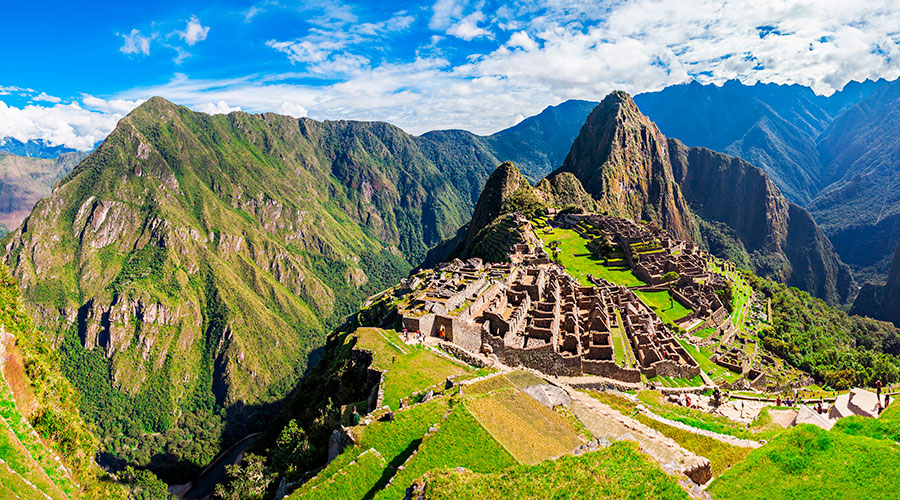
Huayna Picchu mountain from the distance
There are two options for getting back to Cusco. You can either ride the train all the way there, or you can get off at Ollantaytambo and board a bus the rest of the way back to Cusco. I chose the second option for this leg of the trajectory. When we reached Cusco, our guide met us and took us to the hotel, and assisted us with the check-in process.
The next morning, we enjoyed a walking tour of the City of Cusco. The weather was perfect! Some of the recommended highlights include the Plaza de Armas, the local market, and Koricancha.
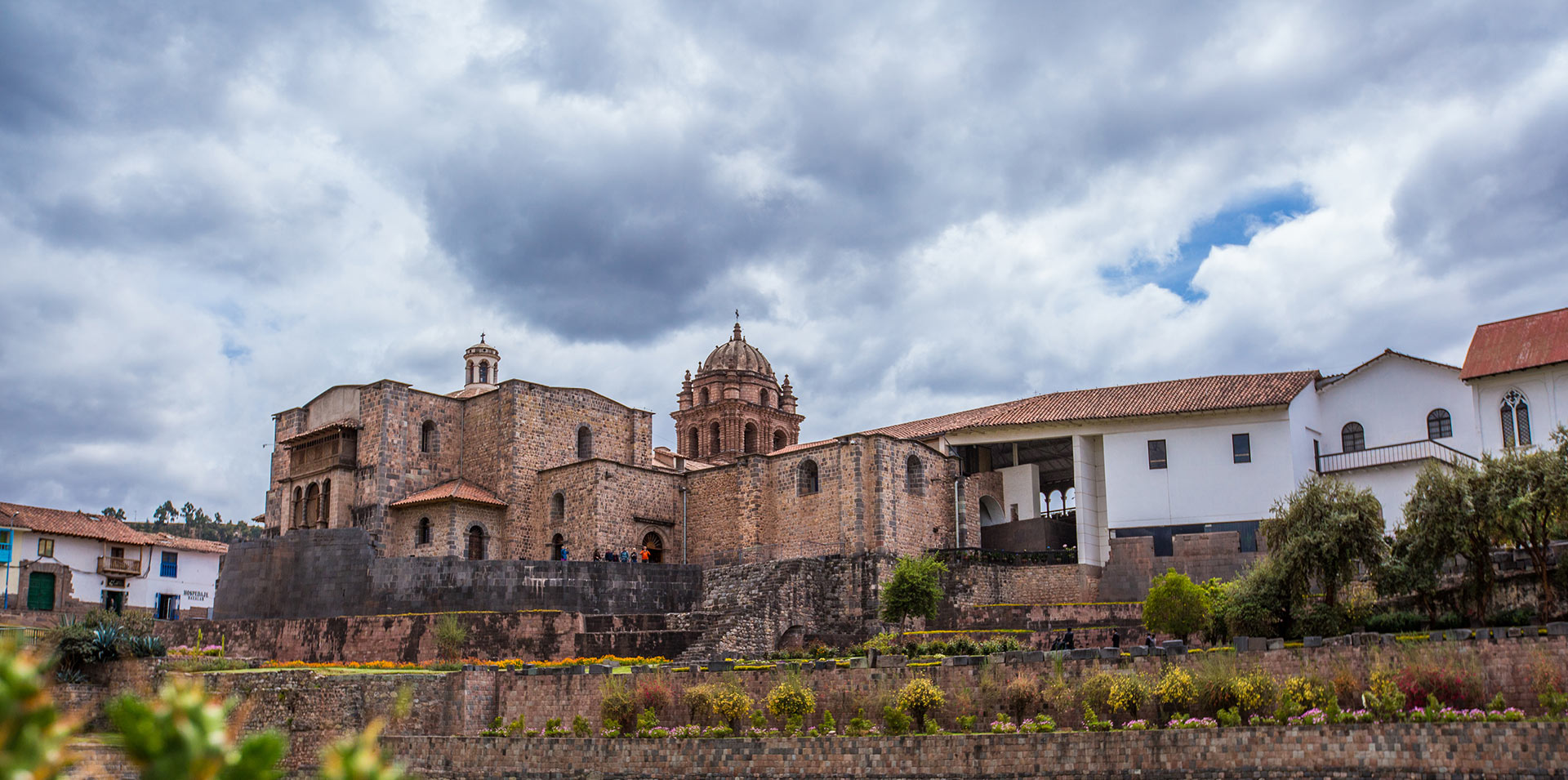
Coricancha Temple in Cusco
We ended our tour with a very delicious lunch before heading over to the airport to catch our flight back to Lima. We spent the night near the airport, at the Wyndham Hotel. The next day, we easily made our way over to the terminal and caught our flight back to Quito. I was a bit tired but so happy to have been able to explore the Galapagos Islands, Lima, the Sacred Valley, Machu Picchu, and Cusco. I’ll never forget this incredible journey!